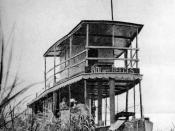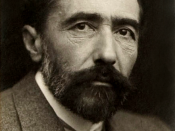An American author, James Baldwin, once said "Not everything that is faced can be changed, but nothing can be changed until it is faced." In a sense, his statement is satisfying to the mind. Mr. Baldwin may have meant that all problems may not always be solvable, but you can't fix any problem if you don't "face" it. Just as everyone has the potential for evil within themselves, we too have the potential for true goodness. In many literary works the author attempts to exemplify the evil which lies within by showing many characters which have been, or are being overcome by their inner darkness. In the novel Heart of Darkness by Joseph Conrad we see how Marlow's journey into his ultimate evil, into his inner self, can be a positive experience. By contrasting Marlow with Kurtz, who represents the absolute evil, we can see the two products of an inner evil which has emerged.
Marlow, who defeats his evil, and gains self-knowledge, and Kurtz, who is defeated by his darkness and falls prey to its wrath. In William Golding's Lord of the Flies the author points out how easily people can be over taken by the darkness, how the potential for good can be destroyed by the evil, but ideally how good will triumph. Through an examination of these two works we can see how the darkness within, given the correct environment will surface.
It is clear how one's inner darkness will surface without the restraints of civilization. In the case of Jack and the hunters, the children are accustom to civility, laws, and order. The theme of the children turning into savages depicts how that the fact that parents and teachers were always placing unwanted rules on them, probably caused an initial enjoyment of the lack of civility...


